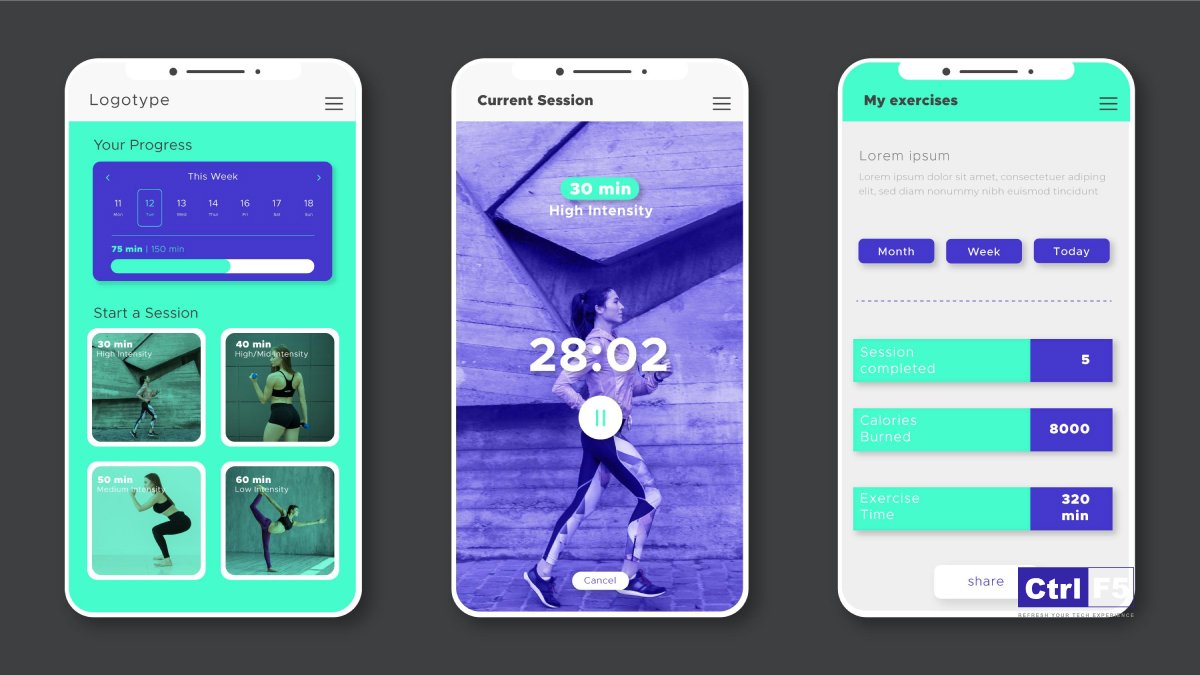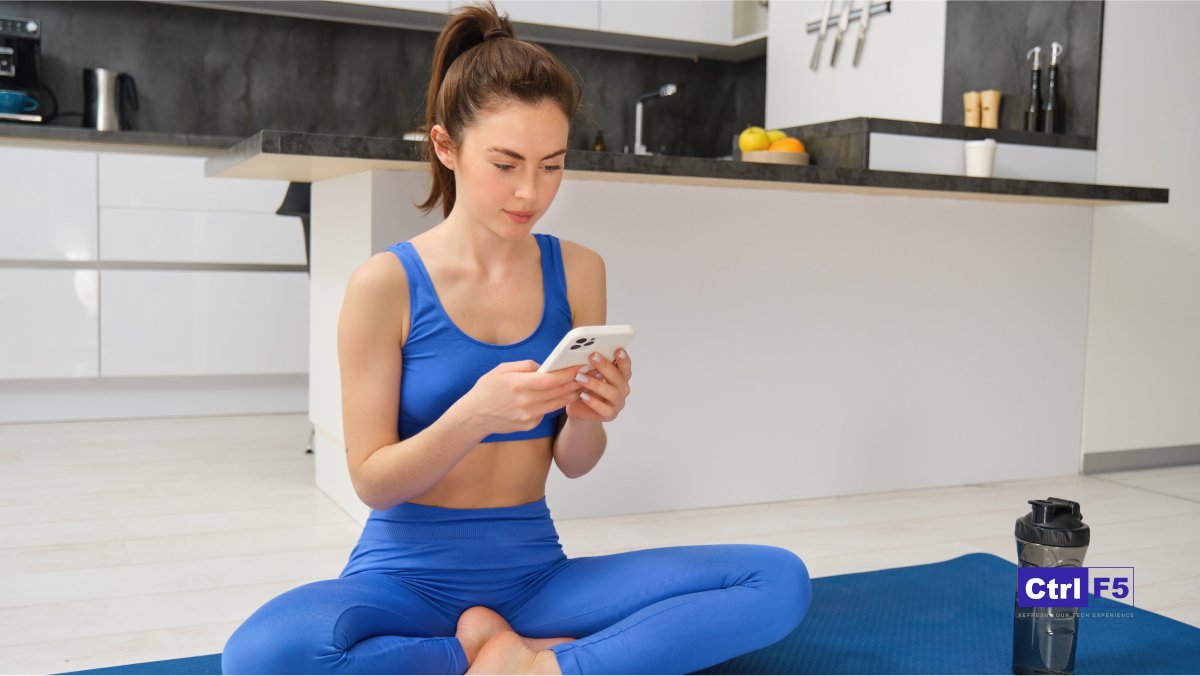How To Create A Mobile App For A Fitness App
- Anurag Pandey
- Last updated on May 14, 2024
- Android, iOS, Mobile Apps
- 15 minutes read
Table of Contents
ToggleMobile apps like Fitness and sports aim to encourage physical exercise and encourage users to develop training habits, have grown in popularity in recent years. The fundamental reason for this is that people are becoming more concerned with their health and well-being. Because of lifestyle changes and rising demand for more accessible workout methods, the fitness industry has undergone a digital transformation to meet the needs of its clientele.
Everyone’s primary priority has always been health and fitness, as fitness has always been a vital building block for our health and wellness. The pandemic has emphasized the significance of regular physical activity even more. However, being healthy and trendy wasn’t as easy back in the day due to the obstacles associated with hiring fitness coaches you’d be completely satisfied with.
The global health and fitness stream has grown constantly up to the high significantly in recent years, owing to expanding smartphone and wearable device use, rising health awareness, and a growing emphasis on fitness and wellness among the general public. This market includes a wide range of mobile applications meant to assist users in tracking their physical activity, maintaining healthy lives, and reaching their fitness goals. And, while the big moment for mobile fitness apps has passed, the possibilities for this category remain optimistic even in the post-pandemic period. The global fitness app market is predicted to be worth $1.3 billion in 2022, with a CAGR of 17.6% from 2023 to 2030.
Given all of this data, it’s no surprise that forward-thinking business owners are investing in fitness mobile app development to acquire market share. This post will teach you how to create a mobile app for a fitness mobile app, as well as the types of fitness mobile apps, monetization models, and fitness mobile app development costs.
Types Of Fitness Mobile Apps
To design a fitness mobile app, you must first decide on its type. ControlF5 is a Top Mobile app development company in India that offers a variety of services to its users, including result tracking, inspiration to keep going, socializing, and even instruction on the subject. It’s like having your own pocket-sized personal coach. What type of fitness mobile app you want to design is one of the most critical questions to ask yourself. Depending on the subject matter, a mobile app may deliver distinct benefits to its users.
Here ControlF5 highlights just some of the most popular options that you may want to consider:
1. Activity Tracking Mobile Apps
The mobile application is designed to track the activities or workouts that a user decides to conduct. They will frequently monitor the number of steps taken, pace, distance traveled, activity duration, and so on in order to determine the calories burned during activities. Some mobile apps may be suitable for runners and cyclists who want more exact metrics measurements.
2. Diet & Nutrition Mobile Apps
These mobile apps are designed to help users measure their food intake and create a personal meal plan. After the user logs the food and drinks they have consumed, they can compute the calories consumed using a vast database. The programs can also develop diet plans and prescribe appropriate activities for a person based on the specific information provided (such as gender, age, height, and weight).
3. Workout Mobile Apps
Workout mobile apps are the third most popular form of fitness mobile app. They function as a personal fitness trainer on your phone, providing workouts, training regimens, and workout guidance. There are usually options for degrees of exercise, frequency, music, and notifications to personalize the user’s experience. Some mobile apps also allow users to tailor workouts or body sections to focus on during a training session.
A few suppliers today have combined all three categories’ functions into one in order to create a more comprehensive user experience and keep users on the mobile app for longer. Fitbit, for example, monitors a user’s activity, gives training tips, and checks caloric consumption. More fitness mobile apps are anticipated to follow likewise in the future.
4. Social Fitness Mobile Apps
Still not motivated? Social fitness mobile apps are an excellent motivation for frequent social media users. Social fitness mobile apps enable users to share their fitness information with friends, family, and other users. Some social fitness smartphone apps, allow users to connect with people who use various fitness mobile apps and gadgets that aren’t typically compatible. Users can also build challenges and competitions that can be shared across various fitness gadget platforms. In today’s social media-obsessed society, everyone wants to share their objectives and triumphs. Social fitness mobile applications accomplish exactly that.
5. Competitive Fitness Mobile Apps
If simply sharing your fitness statistics isn’t enough to motivate you, it’s time to step it up with competitive apps. Some competitive apps allow users to interact with their friends, while others offer a more anonymous competitive drive. Strava is a running and biking competitive mobile app that allows users to compete for the fastest times on specific routes.
6. Altruistic Fitness Mobile Apps
If the additional money in your pocket isn’t enough, consider giving back. With mobile apps like Altruistic Fitness, you can use your workout to benefit a good cause. These mobile apps track your runs and bike rides, allowing corporate sponsors to make donations to your preferred charity for each mile you accomplish. Few things are more inspiring than having the ability to help a social cause that is important to you
10 Steps to Create a Fitness Mobile App
You may design a successful fitness mobile app that meets the demands of your target audience, stands out in the market, and achieves your intended business objectives with the assistance of our dedicated mobile app developers who follow these 10 crucial approaches mentioned below:
Step 1. Identify your mobile app’s mission and audience through market analysis
Determine the key goals of your mobile app, such as weight loss, muscle building, or general fitness. Understand your target audience’s needs, preferences, and motivations in order to create fitness software that effectively caters to them.
Examine the competition, uncover market gaps, and learn about the most popular and effective features in existing fitness mobile apps. This will assist you in developing a distinct value proposition and differentiating your mobile app from competitors.
Step 2. Structure the functionalities for the mobile app
Determine the necessary features to include in your mobile app based on your study and target audience, such as workout libraries, personalized programs, activity monitoring, nutrition tracking, progress analytics, social features, and gamification aspects.
Step 3. Pick the Right Technology Stack
Consider cross-platform compatibility, scalability, and maintainability while selecting technologies, frameworks, and mobile app development tools.
- The framework—Do you want to use the JavaScript-powered React Native, the Dart-powered Flutter, or another cross-platform framework? Determine this ahead of time.
- Integrations—Is it necessary for your software to integrate third-party APIs or to be compiled with social networking platforms such as Facebook? Your choice of services and software will have a huge impact on those integrations, so do your homework.
- Payment systems—How will customers pay for the in-app services? How will suppliers, such as fitness instructors, be rewarded if they are paid per click or download? How will you receive cash for sponsored advertisements? Your choice of software solutions will have a considerable impact on this.
Step 4. Create a User-Friendly UI/UX Design
Create an intuitive, visually appealing, and simple-to-use user interface that improves the user experience. Make sure the mobile app is usable and inclusive of people of all fitness levels and abilities.
Step 5. Developing a Team
When choosing the right team, you have several options to consider:
- In-house team: Hiring a mobile app development team in-house enables for direct communication, control over the development process, and a thorough grasp of your product. However, recruiting, training, and maintaining a staff of talented developers may be time-consuming and costly.
- Offshore dedicated development team: Hiring a specialized web development team through an outstaffing company can save time and money while providing access to a varied pool of competent people. This option provides flexibility because you can scale the crew based on the needs of your project. It also guarantees that the offshore staff is dedicated to your project, understands your objectives, and meets your deadlines.
- Freelancers: While freelancers can provide specialized expertise at a lesser cost, they may not be committed to or available for long-term projects. Communication and project management can sometimes be difficult, potentially resulting in delays and incompatibilities in the final output.
- Hiring agencies: Traditional employment firms can assist in the search for competent developers, but the process can be time-consuming and costly. Furthermore, agencies may not properly comprehend your project’s requirements, resulting in a mismatch between talent and project requirements.
Step 6. Build an MVP (Minimum Viable Product)
Create a streamlined version of your fitness mobile app that focuses on the most important features and functionality. Before putting more time and money into development, an MVP lets you to test your mobile app’s concept with real users, get feedback, and confirm its market potential, with the help of mobile app developers.
Step 7. Develop a mobile app
After knowing that how to design and build MVP from the previous step, you can now create a more complex mobile app with all the features you initially planned. Now, this doesn’t require you to learn code. You can easily find a mobile app development company in India like ours on sites like The Manifest and Clutch. And we will build your mobile app according to the specifications that have been provided by you. This includes front-end and back-end development. In short, the front end is the interface that a user interacts with, and the back end takes care of data processing, storage, and security.
Step 8. Testing the mobile app
Conduct extensive testing while developing a fitness mobile application to ensure its functionality, usability, and performance in order to find and fix any flaws or faults. Use a combination of manual and automated testing, as well as beta testing with real users, to gather useful feedback.
Step 9. Launch, Market, and Promote the mobile app
Release your program to the appropriate mobile app stores (Google Play, Apple App Store) while following their requirements and constraints. Optimize your mobile app store listing with relevant keywords, compelling descriptions, and appealing graphics to increase exposure and downloads.
Create and implement a marketing strategy to increase awareness and user acquisition. Use social media, influencer collaborations, content marketing, and mobile store optimization (MSO) to reach your target audience and increase downloads.
Step 10. Keep an eye on performance and user feedback
Last but not least, Track mobile app usage, user comments, and mobile app store ratings on an ongoing basis to find areas for development and chances for growth. To sustain user engagement and happiness, update and improve your mobile app based on user input and market trends.
Top 4 Best Fitness Mobile Apps In Market
1. MyFitnessPal
MyFitnessPal is the original calorie-counting app, which was launched in 2005. Based on the fundamental idea of calories-in-calories-out, this software provides users with a simple set of tools for tracking their daily calorie and nutrient intake, as well as the calories they expend (via living, breathing, and working out).
Users of MyFitnessPal can catalog each meal by searching the platform’s extensive food database. If a food is not already in the database (which is unusual), they can enter it manually. Users can also scan the barcode label on prepared meals, and if the brand is in the database, the required fields will be immediately filled in. All the user has to do is alter their serving size.
2. Apple Fitness+
Apple Fitness+ is a paid fitness app that is free for the first three months after purchasing an Apple Watch. The obvious advantage of Apple Fitness+ is that it is one of the top Apple Watch Fitness applications because it was created exclusively for the device. As you might expect, Apple Fitness+ smoothly connects with the Apple Watch to track your heart rate, steps, and other vitals.
Apple Fitness+ Plus also provides assistance on other workout regimens such as Pilates, strength training, and yoga. It also provides different workouts each week, as well as guided meditation sessions. After all, a healthy mind depends on a healthy body.
3. Jefit
Jefit is a popular workout app for folks who enjoy weight lifting (also known as resistance training among specialists). The software can track a variety of routines, including cardio training, but it excels at weightlifting.
Users looking for a full-body workout can search the app for routines that target the various muscle groups they want to build. When they do this, all related workouts appear. Users can then acquire the right technique for a variety of strength-training activities.
4. Google Fit
Google Fit is a fantastic achievement by Google. While it may appear to be simply another fitness software (excellent for tracking activities, logging exercises, and so on), what distinguishes it is its ability to interact with an incredible number of apps and wearable devices.
Why does this matter? Essentially, Google Fit acts as a central center for all of your fitness-related mobile apps and gadgets. Assume you use MyFitnessPal to track your diet, an Apple Watch to track your steps, and Jefit to monitor your weight training. Google Fit collects all of that information in one location, where you can review it. It can then provide you with personalized advice depending on your health and exercise history. And yes, it is accessible for iOS devices!
How Much Does It Cost To Build A Fitness Mobile App?
Generally, no one can offer you a precise cost estimate for fitness mobile app development. However, UI/UX design, the area of a mobile app development business, the complexity of your project, features, app development platform, and so on might help you acquire an approximate range.
Based on these parameters, we can estimate that the cost of developing your fitness mobile application will range from $ 5,000 to $ 80,000 or more. (Note: This is only an estimate, and it may vary depending on your mobile app development needs.)
For more information, you can discuss the cost of producing a fitness mobile app with the team.
Monetization Strategies For Fitness Mobile Apps
- Subscription
To gain the benefits of your fitness mobile app, users must purchase it. You might try offering a free trial, and if users realize the usefulness of your software, there’s a good possibility they’ll pay for it or subscribe to continue using it.
- In-app purchases
Provide your users with basic features in the free version and advanced options in the premium version, such as access to more training programs or expert presentations.
- Advertisements
Using this strategy, you embed advertisements into your fitness mobile app to generate revenue. To avoid aggravating users, carefully consider the quantity, location, and duration of the adverts.
- Fees
Working on your fitness mobile app with online fitness experts is part of this plan. Users who use your platform to access a training program will be charged a price.
- Social media sharing
Integrating social media with your mobile app is a wonderful idea that can benefit you in a variety of ways. Users feel more inspired and urge others to adopt a healthy lifestyle when they share their accomplishments with their family and friends. As a result, you can gain new users through their recommendations.
- Schedule your daily plan
Planning your daily agenda within a fitness mobile app will organize your daily workouts efficiently. Users can set specific times for exercise routines, ensuring consistency and accountability. With customizable reminders, individuals can stay on track with their fitness goals throughout the day. This strategy fosters a structured approach to fitness, promoting adherence and long-term success.
- AI-driven chatbot
An AI-powered chatbot integrated into a fitness mobile app provides customers with individualized coaching and support. It uses natural language processing to deliver personalized fitness recommendations, dietary guidance, and motivating messages based on individual goals and interests. Furthermore, the chatbot may provide real-time feedback and encouragement throughout workouts, improving the user experience and increasing consistency.
The Final Thought on How to Create a Mobile App for a Fitness App
Proper research and planning are essential for excellent fitness mobile app development. Understanding your market, carefully considering your goals, hiring the correct team, and ensuring they are well-resourced will dramatically increase your chances of producing fantastic fitness software.
We Controlf5, as a top fitness and healthcare mobile app development company in India, provide you with expertise in developing end-to-end healthcare solutions, including complete wellness platforms. We have innovation-driven UI/UX designer experts, highly skilled backend web developers, and certified mobile app professionals who come together to design and architect a complete roadmap for your fitness mobile app development requirements. Our team has all of the web development and design resources you need to create a fitness mobile app from start to finish. Our developers can collaborate with your in-house team to provide only the additional assistance you require.
Do you want to create a fitness mobile app for your target audience? Want to hire an expert and skilled application development company? Then contact us now..!
Anurag Pandey
Recent Posts
Categories
Hire Developers
About us
Popular Posts
Tags
Related Articles
How to Design an Awesome App User Interface: Full Guide
“A user’s first impression of your website can make or break their decision to explore your site further.”
Creating excellent interfaces that users will love requires effort, but it is rewarding. UI designers excel in both the visual and theoretical parts of interface design.
How To Overcome Cross-Platform Mobile App Development Challenges?
In today’s lightning-fast digital world, mobile applications have become an integral part of our daily lives. Whether utilized for entertainment, productivity, or social networking, they provide consumers convenience and utility across multiple platforms.
Top 9 Mobile App Development Trends in 2024
Ever wondered how many apps are on your phone? Think about it. Every day brings new features and methods to do things. Businesses enjoy a constant flow of clients, indicating the ongoing shift of mobile app development trends. It seems like the mobile app world never sleeps. It’s now time to embrace it!
Sign up for our Newsletter













